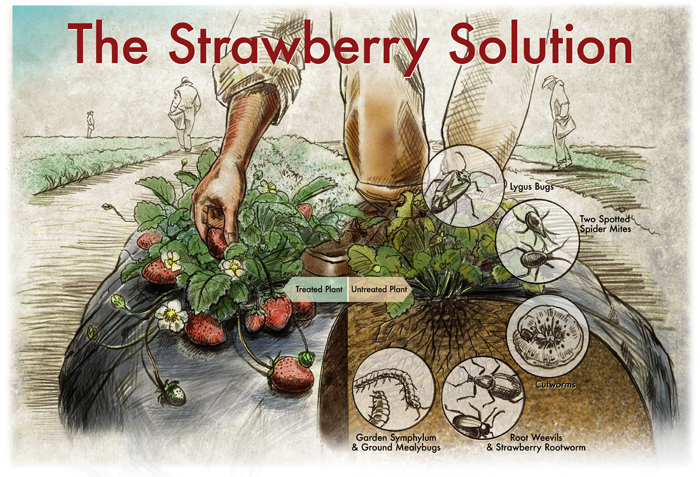
|
| Illustration: Andrew Leach |
| Agroecologists must learn how to grow strawberries without toxic soil fumigants. Stephen Tung picks one compelling alternative. Illustrated by Andrew Leach. |
 |
At the Black Ranch Farm in Salinas, California, rows of tarp-covered strawberry beds fill the fields like consecutive dark speed bumps. Green leaves peep out of tiny holes, their roots protected from airborne weeds and pests. Amid this strawberry patch the size of 40 football fields, there's a peculiar quarter-acre marked by tiny blue and red flags. Numbers in faded white paint denote different sections from 1 to 60. At the end of each section, clear plastic replaces black to allow researchers to peer inside.
Here Joji Muramoto stands in a dark blue shirt and dark blue pants tucked into tall boots, wearing sunglasses and a tan brimmed hat. His four-member team of undergraduates and staff stand in a different row.
“Ready? Set. Go,” he says calmly, starting a stopwatch. They walk quickly down their row, look for unwanted grasses and weeds, and pull them out. When they reach the end of their section, Muramoto notes each of their times: around 45 seconds if there were no weeds, about two minutes if there were. They trudge through the muddy field to put the samples into one of 60 manila envelopes. Then they move on to the next section. “Ready? Set. Go,” Muramoto intones again.
 Above the plastic, the plot studied by UC Santa Cruz researchers looks like the surrounding 53-acre strawberry field. But underneath, there are big differences. Months before, the researchers treated some sections with a traditional mixture of chemical fumigants, which kill pests below the surface. They spiked other plots with mustard cake, a spicy organic alternative that produces toxins to fight bacteria in the soil. Other rows got hit with a new treatment called anaerobic soil disinfestation (ASD), which smothers and kills diseases with organic wizardry. The rest got nothing at all. Above the plastic, the plot studied by UC Santa Cruz researchers looks like the surrounding 53-acre strawberry field. But underneath, there are big differences. Months before, the researchers treated some sections with a traditional mixture of chemical fumigants, which kill pests below the surface. They spiked other plots with mustard cake, a spicy organic alternative that produces toxins to fight bacteria in the soil. Other rows got hit with a new treatment called anaerobic soil disinfestation (ASD), which smothers and kills diseases with organic wizardry. The rest got nothing at all.
Muramoto and his team come to this field, and five others like it, every three weeks to gather data. It's part of an exhaustive set of field trials on California's central coast led by UCSC agroecologist Carol Shennan. During the last seven years, the scientists have shown that some of these techniques just might work in real farm fields. The best new approach may be ASD: In trials, it has killed 70 to 100 percent of a fungus that plagues strawberry growers. One ASD-treated field at the Monterey Bay Academy yielded as much fruit as neighboring plots using PicClor60, a traditional mixture of fumigants.
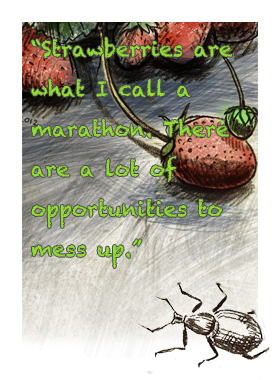 For California strawberry farmers, the time for this research has arrived. In the near future, the Montreal Protocol, an international treaty, will phase out methyl bromide, the most effective weapon for fighting fungi, worm pests, and weeds; the chemical's caustic fumes deplete the ozone layer. Labor and environmental groups protested its proposed replacement, methyl iodide, over health reasons, prompting the manufacturer to pull it from the U.S. market. Indeed, all fumigants may be severely limited in California within the next decade. For California strawberry farmers, the time for this research has arrived. In the near future, the Montreal Protocol, an international treaty, will phase out methyl bromide, the most effective weapon for fighting fungi, worm pests, and weeds; the chemical's caustic fumes deplete the ozone layer. Labor and environmental groups protested its proposed replacement, methyl iodide, over health reasons, prompting the manufacturer to pull it from the U.S. market. Indeed, all fumigants may be severely limited in California within the next decade.
The shift may push more farmers toward growing strawberries organically, but that poses myriad challenges as well. Shennan's team now has a $2.6 million dollar grant from the U.S. Department of Agriculture to study organic methods, from roots to fruits. Rotations with broccoli and lettuce, various cover crops, mustard cake, and ASD are all on the table. All the while, the scientists will examine the environmental impact of each treatment, yields, disease suppression, economics, and the crop's life cycle within each of those permutations.
Organic farmers, who have always lagged behind conventional farmers in yield, finally may close the gap. But it takes a village of data to raise a better strawberry.
Strawberry blues
Strawberries are a multibillion-dollar crop for California, which accounts for 90 percent of the fruit's U.S. production. The land devoted to growing strawberries in the state ballooned from 27,000 acres in 2002 to 38,000 acres in 2012.
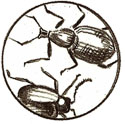 The industry is beset with rising costs. Land, fuel, fumigants, and labor all have grown more expensive, with the estimated total inflation-adjusted costs per acre rising 45 percent from 2001 to 2010, according to UC Davis studies. But the price of fresh berries has remained the same in the last decade—about 70 cents per pound, after adjusting for inflation—due to the increased supply. The stagnant price and climbing costs have shaved profits to thin margins, with growers netting $2,000 per acre on a $17,500 investment, the UC Davis researchers found. When there's a bad growing season, spurred by weather or pests, most farmers think themselves lucky to break even. The industry is beset with rising costs. Land, fuel, fumigants, and labor all have grown more expensive, with the estimated total inflation-adjusted costs per acre rising 45 percent from 2001 to 2010, according to UC Davis studies. But the price of fresh berries has remained the same in the last decade—about 70 cents per pound, after adjusting for inflation—due to the increased supply. The stagnant price and climbing costs have shaved profits to thin margins, with growers netting $2,000 per acre on a $17,500 investment, the UC Davis researchers found. When there's a bad growing season, spurred by weather or pests, most farmers think themselves lucky to break even.
Those slim margins mean that replacing tried-and-true pest-killers with alternatives is a painstaking process. For instance, at the Garroute farms in Monterey, ASD-treated fields yielded 83 percent as many strawberries as conventional fields treated with methyl bromide. However, ASD costs more per acre than the PicClor60 fumigant mixture. That, combined with the slightly lower yield, sinks the profits from a plot of land, says Garroute manager Chris Matthews. He thinks ASD shows promise, but for his farm to adopt it widely, it must be proven consistent, reliable, and economical.
Farmers want the new solutions to work, because they see the end of mainsteam chemical treatments. “The regulatory trend and the ability to use fumigants is strongly downwards,” says Mark Bolda, farm advisor for the UC Cooperative Extension. “Inevitably, the result will be that we're not going to be able to use them.”
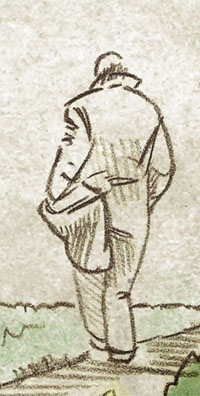 In this climate, strawberry growing has gotten much harder, says Gary Tanimura, who rents out Black Ranch Farms to grow lettuce, artichokes, and strawberries. He mainly grows vegetables, which he considers less temperamental and risky than strawberries. He mixes in berries every couple of seasons because the fumigation used in the growing process clears the soil for subsequent vegetable crops. In this climate, strawberry growing has gotten much harder, says Gary Tanimura, who rents out Black Ranch Farms to grow lettuce, artichokes, and strawberries. He mainly grows vegetables, which he considers less temperamental and risky than strawberries. He mixes in berries every couple of seasons because the fumigation used in the growing process clears the soil for subsequent vegetable crops.
“Strawberries are what I call a marathon,” Tanimura says. While vegetables have a short growing season of about 65 days, the strawberry growing season is especially long: berries are planted in November are harvested from April through November of the following year. An early mistake may affect yields for the entire year. “There are a lot of opportunities to mess up,” Tanimura says. Unsecured tarps, misshapen beds, cold weather, and improper fertilizer mixtures could spell disaster for growers.
In Tanimura's mind, the only recent positive change is the abundance of new varieties. Today's strawberries aren't your parent's strawberries, or even the ones from a decade ago. Horticulturists, mostly from UC Davis, constantly breed new cultivars for better taste, disease resistance, and yields, releasing new ones every two to three years. UC researchers introduced the current king of the hill, the Albion variety, in 2006. The popular Monterey and San Andreas varieties came out in 2009. Those three make up 48 percent of this year's strawberry fields. Further varieties with greater disease-resistance and greater yields may cut the need for fumigants, Tanimura hopes.
For conventional growers like Tanimura, choices come down to economics. Dwindling methyl bromide has become too expensive, doubling in price in the last decade. He already switched from methyl bromide to PicClor60, a fumigant made mostly of chloropicrin, the vital chemical that's mixed with all conventional fumigants to kills pests. This method is cheaper, costing $800 per acre versus $3,000 per acre, but its yields are less. It also requires renting land two months in advance to prepare the fields.
 Tanimura says he expects other growers will use PicClor60 and similar fumigants once methyl bromide is phased out. The other alternatives available today aren't cheap enough. For example, treating a field with a tractor that injects steam into strawberry beds costs thousands of dollars per acre more than conventional treatments, though it's more effective than fumigating with methyl bromide. The machine also takes a full day to treat an acre of soil—far too slow to be scaled up for commercial use. Tanimura says he expects other growers will use PicClor60 and similar fumigants once methyl bromide is phased out. The other alternatives available today aren't cheap enough. For example, treating a field with a tractor that injects steam into strawberry beds costs thousands of dollars per acre more than conventional treatments, though it's more effective than fumigating with methyl bromide. The machine also takes a full day to treat an acre of soil—far too slow to be scaled up for commercial use.
But many growers may have to give up fumigants. The California Department of Pesticide Regulation may tighten restrictions on fumigant use close to schools and homes, requiring growers on that land to use alternatives. Without cheap choices, costs will rise. And if wholesale buyers don't agree to higher prices, the affected farmers may stop growing strawberries altogether.
“The biggest problem will be how this fumigation deal turns out,” Tanimura says. “That will be the determining factor of what's going to happen to the strawberry business out here.”
From Tokyo to California soils
Joji Muramoto keenly senses that quandary. He rushes among the UCSC campus farm and a dozen test farms in the community, gathering data and creating ties that will ease the transition into new ways of farming.
For these practices to take off, one key challenge is building a network of willing farmers, he says. “To do work together, you have to trust each other, right? That takes time.” For the last decade and a half, he has reached out to scores of farmers through the UC extension program by running research trials, sharing early results, and speaking at farming conferences.
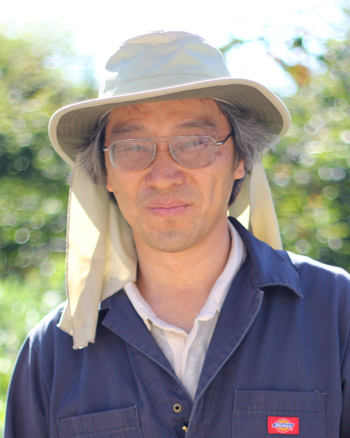 Photo: Stephen Tung
Photo: Stephen Tung |
UC Santa Cruz agroecologist Joji Muramoto
(Click on photo to see larger version.)
|
|
|
Muramoto's motivation sprung from his youth. When he was ten, his six-year-old sister died of leukemia. His mother felt compelled to join the emerging organic movement in Tokyo during the 1970s, even though there isn't a strong connection between leukemia and pesticides. “She wanted to do something after she lost her baby daughter,” Muramoto recalls.
When Muramoto helped on an organic farm during a middle school spring break, a farmer captivated him by telling him that soil was the foundation to farming. That began his “organic sickness,” as he calls it. He joined the gardening club in high school and enrolled at the Tokyo University of Agriculture, earning his bachelor's, master's, and doctorate in soil science.
But in the mid 1990s, the university didn't encourage organic farming research. “I learned a lot, but at the same time, there's limitations to pursuing organic directions. My boss didn't like it,” he says. “At that point, doing organic research was too radical, I think.”
After developing a serious stomach ulcer due to stress, Muramoto decided to leave his tenured position as assistant professor in 1995 to pursue his lifelong organic passion. He joined the budding agroecology program at UC Santa Cruz, where he switched from studying soil nutrients in vegetable crops to those in strawberry fields. “I used the same approach I learned in Japan. A good part of science is that it's global, the same language,” he says.
In 2002, a disease called Verticillium wilt, caused by stubborn fungi that lurk in the soil, infected the test farm at UCSC. Shennan learned about anaerobic soil disinfestation, a new treatment developed independently in the Netherlands and in Japan, from a Dutch colleague. She convinced Muramoto to try the technique.
“It took me a couple of years to get good [results],” he admits.
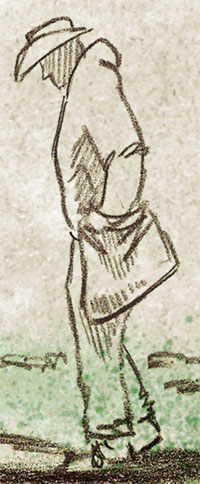 Workers prepare ASD by burying rice bran into the future strawberry beds, laying drip irrigation lines to water the rows, and covering the rows with hundred-foot-long, air-proof tarps. They turn the irrigation on, saturating the soil with water and forcing oxygen out. Under these conditions, microbes chow down the bran, depleting the oxygen in the soil and releasing acetic, butyric, formic, and propionic acids. Those deadly acids kill fungi like Verticillium, as well as nematodes—worms that infest crops. Other unknown biological processes may help out too, Muramoto says. Workers prepare ASD by burying rice bran into the future strawberry beds, laying drip irrigation lines to water the rows, and covering the rows with hundred-foot-long, air-proof tarps. They turn the irrigation on, saturating the soil with water and forcing oxygen out. Under these conditions, microbes chow down the bran, depleting the oxygen in the soil and releasing acetic, butyric, formic, and propionic acids. Those deadly acids kill fungi like Verticillium, as well as nematodes—worms that infest crops. Other unknown biological processes may help out too, Muramoto says.
He and Shennan are still refining ASD; it adds a lot of nitrogen to the soil, which can leach into groundwater. It can also raise salinity in a dry winter, which can damage plants. But it shows results, and that's good news for organic growers. Other than rotating crops, the growers don't treat their soil before planting, and in previous trials ASD increased yields from untreated soil by as much as 45 percent. Organic growers, who lag behind conventional farmers by about 30 percent in yield, may be able to use the technique to catch up.
“Since last year, a lot of growers want to jump on [ASD],” Muramoto says. “We're trying to calm them down. They want to do, like 10 acres.” At Muramoto's coaxing, five organic farmers planted trial plots of an acre or less to learn the ins-and-outs of ASD. If they're successful this season, they may try larger plots next season.
“This is a brand new system for them,” Muramoto says. “If they do 10 acres and fail, they'll never do it again.”
On the down side, current ASD techniques pose major logistical challenges. Farmers must transport a lot of rice bran, requiring 20 trucks for every 60-acre commercial plot of land. Workers put in irrigation lines weeks earlier than usual, and all must be turned on simultaneously. Scaling the technology from a half-acre test plot to a 60-acre commercial farm would be expensive, tricky, and time consuming.
Other questions linger, such as whether farmers could get the same results by using less rice bran or using a different carbon source, like molasses. But Muramoto and Shennan will have the resources to answer those questions. The new four-year, $2.6 million grant from the U.S. Department of Agriculture will focus on organic fields.
Strawberries, holistically
On the 25-acre UCSC farm, beside the greenhouses and the orange trees, there's a peculiar, rectangular plot of land. Mustard weeds run rampant; thousands of tiny yellow flowers dot stalks of grass, like buttered popcorn littered on a carpet of green. But there are also rectangular patches of empty, fallow soil. The edges, marked by two-foot-tall weeds, are as sharp as those between grass and pavement in a neatly manicured lawn.
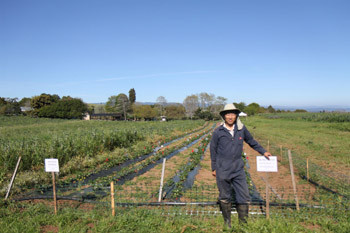 Photo: Stephen Tung
Photo: Stephen Tung |
Joji Muramoto stands before rows of experimental strawberries on the UCSC Farm. (Click on photo to see larger version.) |
|
|
In summer 2012, Muramoto and his colleagues will plant lettuce in some plots and broccoli in the others. But for now it's cover crops: rye, common vetch, and bell beans, which they will till back into the soil to reintroduce nutrients. After the vegetable season, the team will plant cover crops in some plots and strawberries in the others.
The entire field is divided into a grid of 64 mini-fields. Each tiny plot will feature different cover crop plants for varying times, and the scientists will administer ASD to some of them and mustard cake to others. It's like a set of carefully controlled Petri dishes, each with its own set of variables, but out in the open land, exposed to wind, sun, rain, and critters.
The biggest challenge in this research is variability, says Shennan. Diseases, nutrients, and soil types all vary among different sites. “You have to do your experiments multiple times at multiple locations,” she says. But the team also is aware that it cannot micromanage its UCSC plots too much; the extensive data gathering in and of itself could affect the results. “We have to be careful that we don't sample our site so much that we damage our system,” Shennan says, chuckling.
This four-year experiment will look at planting strawberries more realistically in the long-term, not just for one season. Like organic farmers, UCSC growers will rotate broccoli crops to help fight diseases and restore nutrients to the soil. “Everything you see here is what a farmer would do in practice,” says Graeme Baird, a research associate in Shennan's lab. Six of the miniplots are mirrored by plots on organic farms across the region. And if there's one thing the team knows, field data are paramount.
Back on the farm
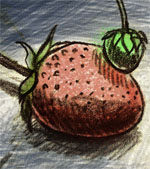 In early March 2012, Muramoto and his team are back at Black Ranch, counting and pulling weeds. By now, the UCSC-managed plants look distinct from their neighbors. Tanimura's leafy strawberry plants are uniformly spaced, but some patches of fallow soil mar Muramoto's plot. His team counts them, diligently. In early March 2012, Muramoto and his team are back at Black Ranch, counting and pulling weeds. By now, the UCSC-managed plants look distinct from their neighbors. Tanimura's leafy strawberry plants are uniformly spaced, but some patches of fallow soil mar Muramoto's plot. His team counts them, diligently.
This winter has been particularly dry. The nitrates released from rice bran for ASD and mustard cake have increased the salinity of the soil, Muramoto observes. Without rain to wash it away, the salt has damaged the plants.
“It's a learning experience,” Muramoto says. In the future they'll try to cut back mustard cake and rice bran rate to lower nitrates, and they'll also try other carbon sources, such as molasses, which release less nitrogen. Some damaged plants might be revived when it rains again. “We'll see how it goes,” he says.
Muramoto notes the data on his clipboard, shakes hands with his student assistants, and drives to his next site in Salinas.
Story ©2012 by Stephen Tung. For reproduction requests, contact the Science Communication Program office.
Top
Biographies
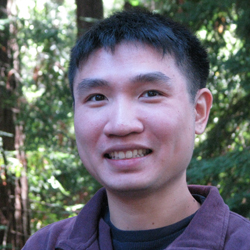 Stephen Tung Stephen Tung
B.S. (mechanical engineering), Cornell University
Internships: Joint Genome Institute, U.S. Department of Energy (Walnut Creek, CA), San Francisco Exploratorium
I love engineering. I designed banks from Legos and air motors from aluminum, my mind always gravitating toward combining smaller parts into something bigger that worked.
My ideas have remained grounded in the functional, but my medium has now changed. Plastic toys and metal have become web code and words. My previous creations connected form to function, but my new ones will connect curiosity to knowledge.
With these tools, I imagine forums for scientists to connect directly with the public, interactive websites that convey how research fits into the larger body of knowledge, and customizing content to give readers exactly the level of detail they want. That's a new design in science communication. I want to be part of it.
. . . . . . . . . . . . . . . . . . . . . . . . . . . . . . . . . . . . . . . . . . . . . . . . . . .
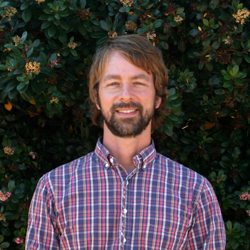 Andrew Leach Andrew Leach
B.S. (landscape architecture) Temple University
B.F.A. (painting) Kutztown University of Pennsylvania
I am an artist, scientific illustrator and a professional landscape architect. At an early age, I was fascinated with birds and nature and would keep a sketchbook full of drawings. These subjects have come back full circle to be my focus lately. I am interested in doing illustrations for field guides and interpretive panels to help educate the public about the natural world around us.
Top
|

